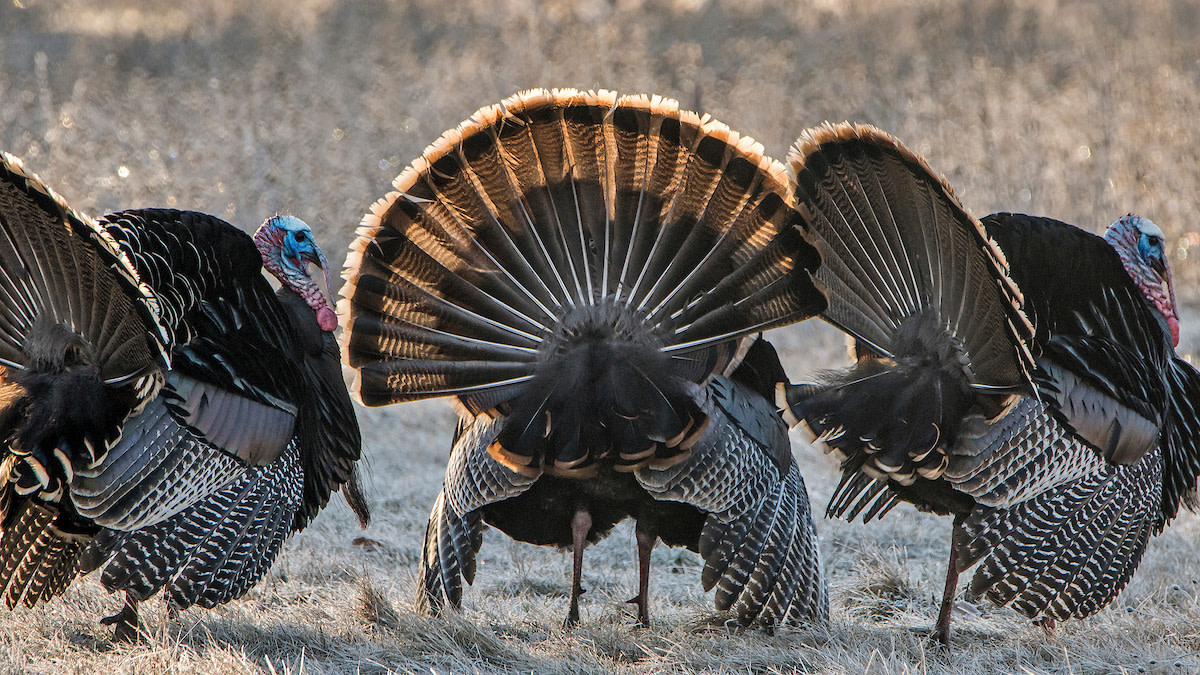
I vividly remember how that spring morning broke over the Ouchita National Forest. Still darkness gave way to dark blue as the predawn light slowly snuffed out the starlight sprinkled above the creek drainage below. The shriek of the morning’s first bird call disrupted the tranquility—a piercing chirp from a robin roosted overhead. The morning bird chorus grew slowly as new avian species chimed in and announced their eagerness to procreate.
Perched on that bluff I felt as if I could hear and see a mile in each direction while every bird species of Arkansas rattled the hardwoods in song. Every species, that is, except the one I came to hear, the Eastern wild turkey. This was my welcome to the front lines of the turkey population crisis.
I’m certainly no habitat expert, but what I saw stretched out before me seemed to offer the full package to support healthy flocks of turkeys. In talking to the locals, it seemed as if these now-silent mountains once echoed with gobbles after successful restoration efforts. Declining harvest reports spanning the last 40 years suggest they’re right.
“You didn’t hear any turkeys because there aren’t any turkeys left in Arkansas,” my buddy Matt offered hyperbolically in response to my head-scratching. A fellow passionate turkey hunter, this Arkansan expat set roots further east in Mississippi, where bird populations appear in a gentle slide as opposed to a tailspin.
Across the region, though, turkey hunters and biologists have sounded the alarm. Numerous contributing factors appear to be in play, including some we’re eager to talk about (predators and habitat) and others with less palatability among sportsmen and women (hunter harvest and season timing). I encourage you to pore over the emerging wild turkey research by Dr. Michael Chamberlain and others for a deep dive into the population crisis.
Back in my home state of Idaho, it’s hard to imagine these same conditions ever plaguing our healthy turkey flocks. Out here, we’re currently living in the good old days of the sport, where numbers remain so robust that the state has trapped and transferred nuisance birds and opened up liberal fall seasons in most northern units to keep landowner complaints and bird numbers in check.
While we celebrate the successful introduction and establishment of the wild turkey beyond its native range and into the West, perhaps we should keep an eye on the population crisis back East as a harbinger of conditions migrating our way.
Out here where big game reigns supreme, spring turkey hunting isn’t woven into the historical fabric of the outdoor community like it is east of the Mississippi, for better and worse. Generally, these introduced birds are treated as a welcomed source of revenue and sport but kept at arm’s length when tightened budgets prioritize the management of native species. Fish and game agencies that field numerous nuisance calls when giant winter flocks wreak havoc on local agriculture may have a different opinion.
Conversely, state agencies in the West likely don’t encounter the same degree of pushback in modifying flock management strategies as their southern counterparts, who must buck longstanding sporting traditions to bring turkey numbers out of a nosedive. Without a doubt, adjusting season opening days, lengths, and bag limits in states with rich turkey hunting history has been met with every reaction from reluctant acceptance to outright scorn.
Fortunately, most Western seasons already align well with breeding seasons. This strategy allows for the bulk of the fertilization to take place before hunting pressure disrupts flocks and removes dominant males from the landscape after their reproductive contribution is complete for the year. Likewise, Western bag limits in the spring season are modest compared to those historically found across the deep South.
Admittedly, it’s hard to imagine anything threatening turkeys in the West. They’ve eagerly taken hold in seemingly every pine and cottonwood-choked drainage from the Dakotas to the Pacific Ocean. These birds have staked a claim on a landscape filled with nest-raiding predators and harsh weather.
With conscientious management, I remain optimistic that our healthy flocks continue in a growth phase. With so many opportunities, it’s easy to allow complacency at feast time to ignore the insidious indicators of famine. Could we be approaching the precipice our fellow hunters in the Southeast reached 30 years ago, unknowingly peering over the same descent to catastrophe? Not likely, but it’s worth keeping their fate in mind when we expand harvest opportunities and adjust seasons.






Conversation